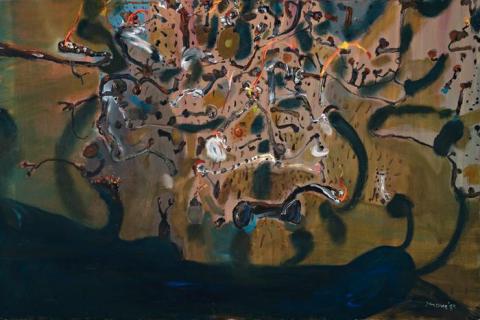BURNING TREES, PILBARA, 1983
John Olsen
oil on canvas
111.5 x 167.5 cm
signed and dated lower right: John Olsen ‘83
Christensen Fund Collection, Perth
Private collection, Victoria c.1989
Christie's, Melbourne, 27 April 1999, lot 149
Private collection, Melbourne
John Olsen: The Land Beyond Time, Art Gallery of Western Australia, Perth, then touring nationally, May 1983 – February 1990, cat. 84
Olsen, J. et al., The Land Beyond Time, Macmillan Company of Australia Pty Ltd, 1984, pp. 196–7, titled in artist's hand, 'Aftermath of Fire', (illus.)
Christensen, A., 'Introduction' in Olsen, J., The Land Beyond Time: Paintings and Drawings by John Olsen, Christensen Fund Collection, Art Gallery of Western Australia, 1984, cat. 84 (illus.)
In August 1982, John Olsen left on a ten-week journey of 'modern exploration of Australia's North-West Frontiers.'1 Sponsored by the Christensen Fund, it included a diverse group of talented people aiming 'to set down by paintings, poetry and prose a distillation - for the rest of us.'2 The natural scientist among them was Vincent Serventy, with Mary Durack as author and historian, Geoffrey Dutton, poet and writer, and Alex Bortignon as project manager and photographer. Some fifteen months later the book, The Land Beyond Time, was published, documenting the expedition and its participants' responses. Olsen's numerous drawings and paintings, to which Burning Trees, Pilbara belongs, were exhibited under the same title as the book, and toured Australia-wide over several years.
The inspiration behind Olsen's 1982 paintings Burnt Tree and Burning Trees series, and Burning Trees, Pilbara, 1983, is perceptively captured by Serventy in the following paragraph from their book of record:
'Fires burned through much of this country during the dry season, and when we looked down from the helicopters we were all struck by the almost perfect outlines of trees drawn in ash on the brown soil. They would have been created when fire ate slowly through the bases of the trees until they crashed to the ground, where the fires continued to convert all the timber, including the topmost branches, to ash. John found these patterns of nature irresistible and by the end of the flight he had covered page after page of his notebook with sketches.'3
In Burning Trees, Pilbara Olsen's brush picks up the spectacle of the aerial view, its wonderment, visual excitement and vastness of the region. No doubt mindful of Serventy's observation- 'The whole region is a portion of that enormous art gallery which stretches across northern Australia.'4 Olsen sets up a rhythmic movement of curvaceous black forms, white ash and highlights of flickering red and yellow flames across a chocolate brown land. The shadows of the helicopters link the viewer and the view as evidence of their presence in this theatre of natural splendour.
1. The Land Beyond Time, Macmillan, op. cit., titlepage
2. Quoted in Hart, D., John Olsen, Craftsman House, Sydney, 1991, p. 155
3. Serventy in The Land Beyond Time, ibid., p. 204
4. ibid
DAVID THOMAS
